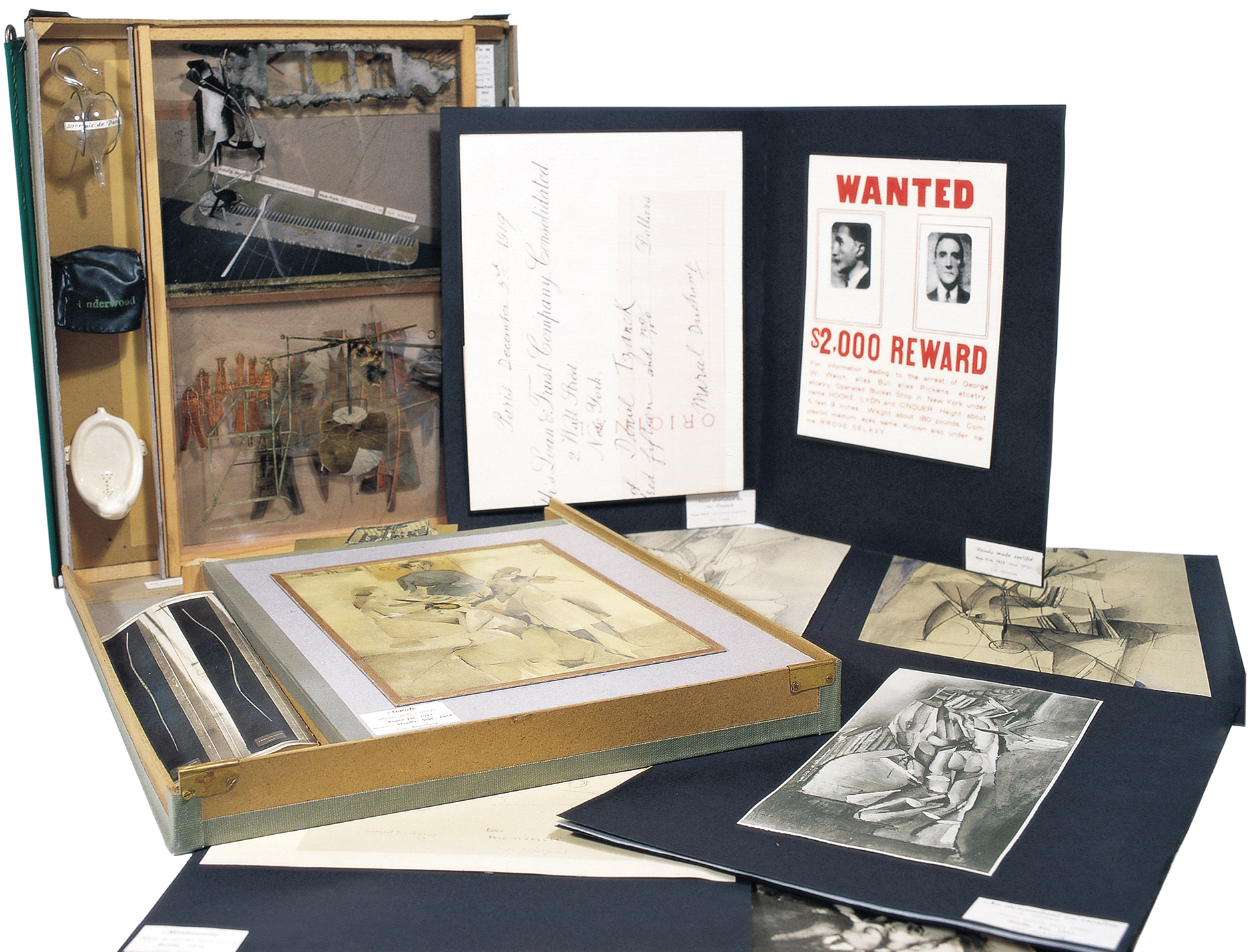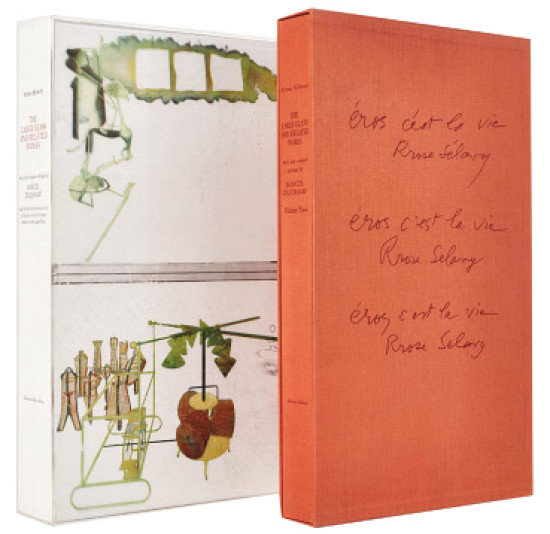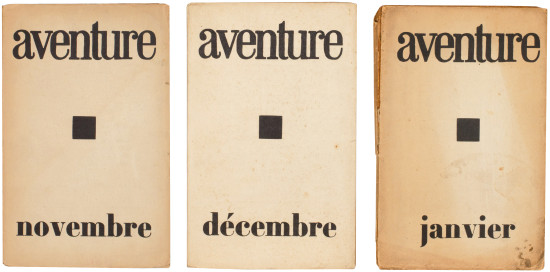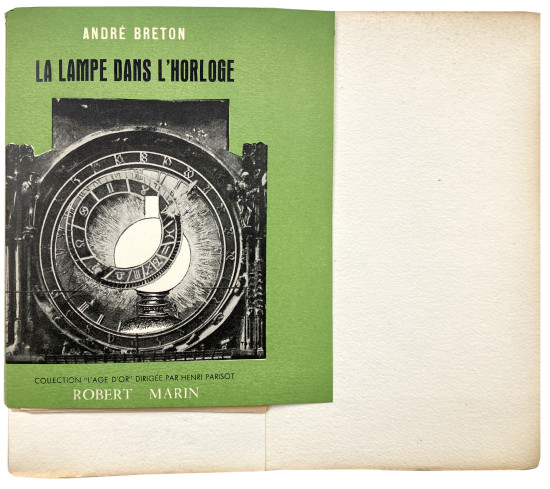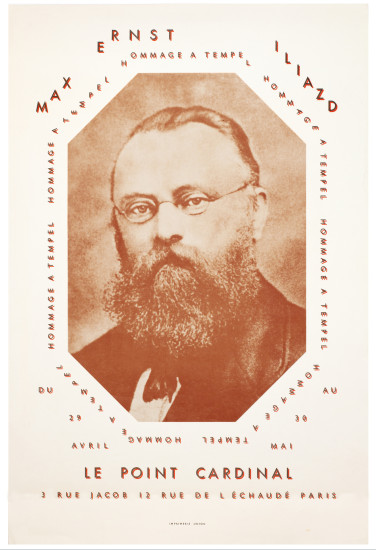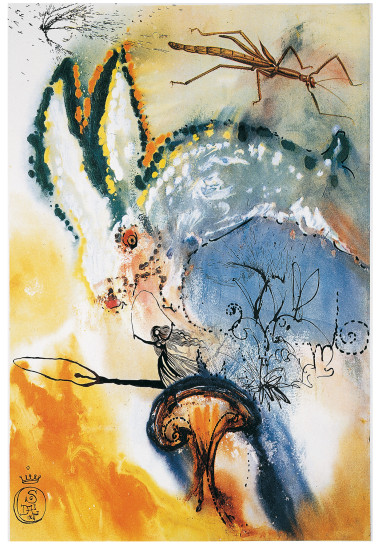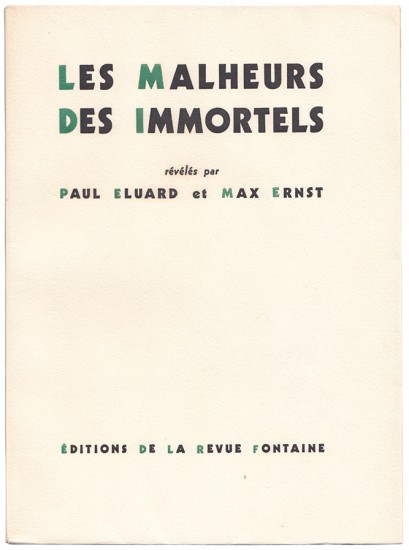From or by Marcel Duchamp or Rrose Selavy (The Box in a Valise). (La Boîte-en-Valise)
Duchamp, Marcel
Paris. Marcel Duchamp. 1941–1958
A very scarce copy of Marcel Duchamp's 'La Boîte-en-Valise' with a triple presentation from Duchamp.
From the Series 'C' issued in Paris in 1958, limited to 30 unnumbered copies, and assembled by Iliazd (Ilia Zdanevitch); this edition 'C' is usually unsigned but this example has three signed presentations from Duchamp, two dated '1958' (the year this issue was assembled), on the upper cover of the contents in white paint: 'To Art Buchwald / Marcel Duchamp / Cordialement / 1958', to the inserted bifolium with a colour reproduction of Duchamp's 'Rotorelief / Disque Optique' in blue ink: 'pour Art Buchwald / Cordialement / Marcel Duchamp / 1958' and to the sheet reproducing the 'Cimetière des Uniformes et Livrées' in blue ink: 'To Buchwald / Art Marcel Duchamp'.
Arthur 'Art' Buchwald (1925 - 2007) was an American humourist, journalist and satirist best known for his long-running syndicated column for The Washington Post in which he lampooned the rich, the famous, the political classes and indeed anyone he thought worthy of ridicule. Buchwald won the Pulitzer Prize in 1982.
Series 'A' and 'B' were issued, firstly, in Paris, just before Duchamp's departure for New York, but the majority issued when Duchamp had arrived in New York. There were 20 de luxe copies of Edition 'A' and between 60 - 75 unnumbered boxes for edition 'B' (approx. 25 - 35 were issued in leather valises) which were assembled during the war years by Joseph Cornell, Xenia Cage, Patricia Matta Kane, and others. Series 'A' was issued between 1941 and 1949; series 'B' was issued between 1941 and 1954.
Series 'C' - as for the present example - was issued in Paris in an of edition of 30 copies assembled by Iliazd: 'For this series, Duchamp added a label for the Arensberg Collection (which had entered the Philadelphia Museum of Art collection in 1950) pasted into a black folder. He also included new castings of the miniature, three-dimensional reproduction of Fountain, 1917. These castings, however, were not as successful as those incorporated in the Series B, New York edition. Duchamp sent the contents for this edition to Paris from New York in 1956. The French Customs refused to recognise them as works of art and allowed them to be reimported as samples'. (Schwarz).
Series 'D' was issued in 1961 in 30 examples and assembled by Jacqueline Matisse Monnier. Series 'E' was issued in 1963 in an edition of 30, unnumbered, and also assembled by Jacqueline Matisse Monnier, and enclosed in a dark green imitation leather valise. Series 'F' was issued by Arturo Schwarz in 1966 in an edition of 75 in red leather valises. Series 'G' was also issued by Arturo Schwarz in an edition of 47 between 1966 and March 1971.
'Duchamp worked for five years (1935 - 40) in Paris on the material for his 'portable Museum' assembling photographs and supervising colour reproductions of his works ... A subscription bulletin issued in Paris in 1940 announced the publication date of this item as January 1, 1941. However, because of the war (Paris had fallen to the Germans in June 1940), Duchamp assembled most of the items a few months later, in New York, after having smuggled the elements separately out of Occupied France in the course of several trips which he made armed with a cheese merchant's identity card ... In an interview with James Johnson Sweeney, Duchamp explained his reasons for The Box in a Valise: 'It was a new form of expression for me. Instead of painting something the idea was to reproduce the paintings that I loved so much in miniature. I didn't know how to do it. I thought of a book, but I didn't like that idea. Then I thought of the idea of a box in which all my works would be mounted like in a small museum, a portable museum, so to speak, and here it is in this valise.'
'Characteristically,' observed Robert Lebel, 'one year before the war Duchamp foresaw that he must pack his bags in as small a space as possible ... '. (Schwarz).
[Schwarz 484].
From the Series 'C' issued in Paris in 1958, limited to 30 unnumbered copies, and assembled by Iliazd (Ilia Zdanevitch); this edition 'C' is usually unsigned but this example has three signed presentations from Duchamp, two dated '1958' (the year this issue was assembled), on the upper cover of the contents in white paint: 'To Art Buchwald / Marcel Duchamp / Cordialement / 1958', to the inserted bifolium with a colour reproduction of Duchamp's 'Rotorelief / Disque Optique' in blue ink: 'pour Art Buchwald / Cordialement / Marcel Duchamp / 1958' and to the sheet reproducing the 'Cimetière des Uniformes et Livrées' in blue ink: 'To Buchwald / Art Marcel Duchamp'.
Arthur 'Art' Buchwald (1925 - 2007) was an American humourist, journalist and satirist best known for his long-running syndicated column for The Washington Post in which he lampooned the rich, the famous, the political classes and indeed anyone he thought worthy of ridicule. Buchwald won the Pulitzer Prize in 1982.
Series 'A' and 'B' were issued, firstly, in Paris, just before Duchamp's departure for New York, but the majority issued when Duchamp had arrived in New York. There were 20 de luxe copies of Edition 'A' and between 60 - 75 unnumbered boxes for edition 'B' (approx. 25 - 35 were issued in leather valises) which were assembled during the war years by Joseph Cornell, Xenia Cage, Patricia Matta Kane, and others. Series 'A' was issued between 1941 and 1949; series 'B' was issued between 1941 and 1954.
Series 'C' - as for the present example - was issued in Paris in an of edition of 30 copies assembled by Iliazd: 'For this series, Duchamp added a label for the Arensberg Collection (which had entered the Philadelphia Museum of Art collection in 1950) pasted into a black folder. He also included new castings of the miniature, three-dimensional reproduction of Fountain, 1917. These castings, however, were not as successful as those incorporated in the Series B, New York edition. Duchamp sent the contents for this edition to Paris from New York in 1956. The French Customs refused to recognise them as works of art and allowed them to be reimported as samples'. (Schwarz).
Series 'D' was issued in 1961 in 30 examples and assembled by Jacqueline Matisse Monnier. Series 'E' was issued in 1963 in an edition of 30, unnumbered, and also assembled by Jacqueline Matisse Monnier, and enclosed in a dark green imitation leather valise. Series 'F' was issued by Arturo Schwarz in 1966 in an edition of 75 in red leather valises. Series 'G' was also issued by Arturo Schwarz in an edition of 47 between 1966 and March 1971.
'Duchamp worked for five years (1935 - 40) in Paris on the material for his 'portable Museum' assembling photographs and supervising colour reproductions of his works ... A subscription bulletin issued in Paris in 1940 announced the publication date of this item as January 1, 1941. However, because of the war (Paris had fallen to the Germans in June 1940), Duchamp assembled most of the items a few months later, in New York, after having smuggled the elements separately out of Occupied France in the course of several trips which he made armed with a cheese merchant's identity card ... In an interview with James Johnson Sweeney, Duchamp explained his reasons for The Box in a Valise: 'It was a new form of expression for me. Instead of painting something the idea was to reproduce the paintings that I loved so much in miniature. I didn't know how to do it. I thought of a book, but I didn't like that idea. Then I thought of the idea of a box in which all my works would be mounted like in a small museum, a portable museum, so to speak, and here it is in this valise.'
'Characteristically,' observed Robert Lebel, 'one year before the war Duchamp foresaw that he must pack his bags in as small a space as possible ... '. (Schwarz).
[Schwarz 484].
Folio. (400 x 376 x 92 mm). 68 miniature replicas and colour reproductions of works by Marcel Duchamp inserted or placed loosely as issued in the original grey coarse-weave cloth box.
#46949
